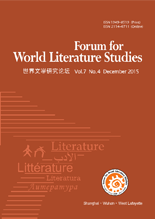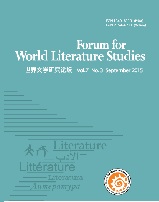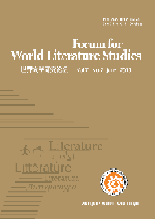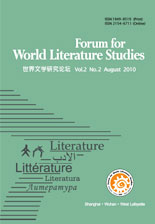Ethical Literary Criticism: International Perspectives
Shang Biwu
School of Foreign Languages, Shanghai Jiao Tong University
800 Dongchuan Road, Shanghai 200240, China
Email:[email protected]
Abstract This article is an introduction to the thematic cluster “Ethical Literary
Criticism: International Perspectives.” It begins with a brief overview of recent
works on ethical literary criticism in the West and those produced in the East,
suggesting a necessity for a dialogue between Western perspective and Oriental
perspective. The bulk part of the article is devoted to explicating the major
arguments of all the contributions. In doing so, it reveals that Western ethical
literary criticism, assimilated either by philosophy or by narratology, has hardly
developed into an independent school of critical theory, while Chinese ethical
literary criticism, with its distinctive terminologies and critical frameworks, has
emerged as an exciting new critical theory.
Key words ethical literary criticism; philosophy; narratology; stylistics; sociology
Author Shang Biwu is a Distinguished Fellow of English at Shanghai Jiao Tong
University, Fellow of the National Humanities Centre, United States, and editorin-
chief of Frontiers of Narrative Studies. His areas of research include narrative
theory, ethical literary criticism, and twenty-first century fiction. An author of In
Pursuit of Narrative Dynamics (2011) and Contemporary Western Narratology:
Postclassical Perspectives (2013), he has published about seventy articles, critical
notes, and book reviews in such international journals as Style, Language and
Literature, Journal of Literary Semantics, Modern Fiction Studies,CLCWeb:
Comparative Literature and Culture, Semiotica, Primerjalna književnost, Foreign
Literature Studies, and arcadia: International Journal for Literary Studies.
The second decade of the twenty-first century witnessed a new upsurge of ethical
criticism in Western academia, which is saliently evidenced in such works as Steve
Brie, and William T. Rossiter’s Literature and Ethics: From the Green Knight to
the Dark Knight (2010),Toker Leona’s Towards the Ethics of Form in Fiction:
Narratives of Cultural Remission (2010), David Parker’s Ethics, Theory and the
Novel (2011), Jakob Lothe, and Jeremy Hawthorn’s Narrative Ethics (2013), Nora
Berning’s Towards a Critical Ethical Narratology: Analyzing Value Construction
in Literary Non-Fiction across Media (2013), Adam Zachary Newton’s To Make
the Hands Impure: Art, Ethical Adventure, the Difficult, and the Holy (2014), and
Liesbeth Korthals Altes’s Ethos and Narrative Interpretation: The Negotiation
of Values in Fiction (2014), to name a few. Equally noteworthy is the popularity
of ethical approach to literature in the East, which is largely in debt to the rise
of ethical literary criticism proposed by Nie Zhenzhao. Ethical literary criticism,
according to Nie, designates “a critical theory that reads, analyzes and interprets
literature from the perspective of ethics so as to identify its ethical nature and
moral teaching function” (Nie13). Unlike Western ethical criticism, which has been
assimilated either by philosophy or by narratology, ethical literary criticism has
fully fledged into an independent school of critical theory in China.
When talking about the nine lives of theory, Jane Elliott and Derek Attridge
observe that “ ‘Theory’ was never a single, self-identical object and, in fact, one
of its signature reflexes was the resistance to such ‘totalizing’ groupings, which
were usually seen to commit the epistemological violence of reducing the rich
heterogeneity of a complex field to a single homogeneous concept” (Elliott and
Attridge 2). Along somewhat similar line, one can postulate that ethical criticism
has never been a single and unified grand theory. At issue is what we are supposed
to deal with, in particular, the plethora of ethical criticism developed against
different critical traditions. About the correlations between ethical criticism and
other critical approaches, Marshall Gregory suggests that “What the humanities in
general need is an ethical criticism that is intellectually defensible, not to replace or
displace other critical approaches but to complement them”(Gregory 194). I’d like
to further extend Gregory’s argument by claiming that different strands of ethical
criticism are not to replace each other but rather to form a type of complementary
relation. To this end, in “The Rise of a Critical Theory” (2014), I place much
emphasis upon the dialogue between ethical criticism in the West and ethical
literary criticism in China, and I firmly believe that “the more our exchanges
involve a sharing of ideas about the two traditions and innovations, the more we
can learn from each other and the more productive the relationship is likely to be”
(Shang 35).
My expectations have been largely fulfilled by the 4th International Symposium
on Ethical Literary Criticism held in Shanghai Jiao Tong University from December
19th to December 21st, 2015. As an organizer of this conference, I was delighted to
see it attended by nearly 300 scholars from more than 10 countries and regions,
including the United States, England, Germany, Russia, Norway, Hungary, Estonia,
South Korea, Malaysia, Taiwan, Hong Kong, and Mainland China. Among these
attendants are not only the graduate students and young scholars eager to join the
academic community but also quite a few eminent, experienced, and internationally
recognized scholars. To name a few, Marjorie Perloff, Charles Bernstein, Ansgar
Nünning, Vera Nünning, Péter Hajdu, William Baker, Geoff Hall, Jüri Talvet, Brian
Reed, Knut Brynhildsvoll, Simon C. Estok, Igor Olegovich Shaytanov, Youngmin
Kim, Yuanmai Wu, Zhenzhao Nie, and Di Wu. There were all together 17 plenary
speeches and 14 panel sessions, embracing a diverse array of broad topics, such
as theoretical explorations of ethical literary criticism, ethical literary criticism
and interdisciplinary studies, and ethical literary critical perspective on national
literature, in addition to a wide range of issues thoroughly explored and heatedly
discussed.
The current thematic cluster is one of the most fruitful results of this
conference, featuring international perspectives on and multiple approaches
to ethical literary criticism. It begins with Charles Ross’s interview with Nie
Zhenzhao, the Chinese founder of ethical literary criticism. In this wide-range
interview, Nie elaborates the definition of ethical literary criticism, the origin
and function of literature, and the ethics/morality distinction. In particular, he
says much about the differences between ethical literary criticism and aesthetic
criticism. In Nie’s opinion, ethical literary criticism sees literature as a moral means
for undertaking ethical selection; while aesthetic criticism regards literature as a
sensual means for aesthetic appreciation. Equally illuminating is Nie’s elaboration
of natural selection and ethical selection, which are considered as the two pillars
of his critical enterprise. Arguably, ethical selection is the second selection after
natural selection in the history of human civilization. Completing natural selection,
human beings must undergo ethical selection so as to transform “animal man” into
“ethical man.”
Nie’s oriental perspective on ethical literary criticism is met with Western
perspectives starting with Ansgar Nünning’s paper, which forcefully argues
that narrative theory and ethical literary criticism should be seen not as strange
bedfellows but as natural allies, despite the regrettable fact that classical
narratology largely ignored questions concerning context, history, interpretation,
norms and values, while ethical criticism has not been much concerned with
formal issues or narrative techniques. In his article, Ansgar, apart from offering an
overview of the different trajectories of narratology and ethical literary criticism,
and the recent attempts at reconciling and synthesising narratological and ethical
approaches, lays out the premises and concepts of narratology and ethical literary
criticism to do each others’ service. In doing so, Ansgar concludes that “the more
narratological ethical literary criticism becomes, and the more interested in ethics
and the dissemination of values narratology becomes, the better for both.”
Ansgar’s attempt to combine the insights from narratology and ethical literary
criticism is further consolidated by Vera Nünning’s efforts. In her contribution, Vera
dwells on the cognitive and ethical potential of fictional narratives. As a part of her
larger project in Reading Fictions, Changing Minds (2014), Vera’s essay aims to
synthesize psychological research and the theory of narrative. Taking the findings
from recent psychological study on the persuasive power of fictional stories to
change readers’ beliefs and to improve readers’ cognitive abilities, Vera focuses on
the potential of fiction to enhance readers’ abilities of social cognition, and reveals
how ethical issues are intricately involved in the cognitive processing of fictional
narratives. Thought-provoking are the future directions outlined by Vera, such as
the cognitive potential of popular fiction, the hierarchies of values embedded in
fictional stories, and possible links between the values disseminated in a story and
the genre it belongs to, all of which deserve an in-depth exploration and set up a
scholarly agenda for the rest of us.
Equally interdisciplinary is Geoff Hall’s contribution, which tries to bring
together the strengths of stylistics and ethical literary criticism. As an established
scholar of stylistics, Hall is fully aware of the fact that both stylistics and ethics are
essentially about choices: stylistics is the study of linguistic choices, while ethics is
the study of moral choices. That said, stylistics and ethical criticism can be brought
into a fruitful dialogue if one starts from the idea of choice, which, in Hall’s view,
is “a notion basic to both stylistics and to ethics.” The words used in a text and
the words that readers express preferences and perspectives often have an ethical
import. Specifically, Hall takes Henry James’ fictions as an object of analysis,
demonstrating how a stylistic awareness can help critics to pin down the ethical
implications of literary texts.
Like the Nünnings and Hall, Knut Brynhildsvoll also intends to reconsider
ethical literary criticism from an interdisciplinary perspective. However, there are
substantial differences in their explorations: in the contributions by the Nünnings,
the counterpart of ethical literary criticism is narratology; in Hall’s contribution, the
counterpart is stylistics; while Brynhildsvoll attempts to shed a new light on ethical
literary criticism from the science of sociology. In particular, Brynhildsvoll intends
to examine the changing ethical evaluations with reference to Norbert Elias and
Peter Dürr. In doing so, he argues that as far as ethical criticism aims at obtaining
a change in the reader’s mind, it depends on the inherent capacity of the text to
transcend his/her expectation horizon and create an awareness of the need for a
spiritual renewal.
While the above scholars’ contributions are marked by their synchronic
feature, Kenneth Womack and William Baker’s draws a brief review of Anglo-
American ethical criticism diachronically. Observing that “ethical criticism’s
fusion with continental philosophy has produced a more theoretically rigorous
form of literary critique that continues to elevate its status as a viable interpretive
mechanism,” Womack and Baker bluntly claim that “ethical criticism offers a
valuable lens for examining the manner in which literary characters experience
moments of moral clarity and interpersonal change.” To illuminate this argument,
they take Ford Madox Ford’s Parade’s End as an object of analysis. With reference
to Levinas’s ethical philosophy and its critical matrix of alterity, they try to
reveal Ford’s ethical imperatives in Parade’s End, which aims at altering readers’
perspectives of war and atrocity via his well-honed Impressionistic techniques.
As a Vice-president of International Association for Ethical Literary Criticism
(IAELC), Jüri Talvet embraces Nie’s ethical literary criticism and speaks highly
of the newly founded IAELC, the mission of which, in Talvet’s opinion, is “to
initiate a new trend of international literary scholarship that would form a certain
counterweight to Western literary studies, which at least since the last quarter of
the 20th century have indeed oscillated between two extremes: on the one hand,
linguistic-formalistic research (including narratology, cognitivistics, language
philosophy applied to literature, etc.); on the other hand, sociological approaches
(discourses on power relations, postcolonial scholarship, gender studies, etc.).”
Talvet agrees with Nie in claiming that “there was very little hope that big or small
‘peripheries,’ if they continued to follow the main fashionable trends proceeding
from Western ‘centers,’ could ever contribute to universal literary scholarship or
world literature studies by their own, original points of view, reflecting realities
beyond ‘centric’ Western literary currents and criticism and their faithful imitations
in the ‘periphery.’” In his contribution, Talvet reflects upon the possible origin
of Western ethical literary criticism in Dante Alighieri’s philosophical treatise
Convivio, assuming that the formation of a theory/philosophyof ethical literary
theory ran in parallel with ethical practice in the first great European literary
masterpieces of the budding new era — Dante’s own monumental Comedia and the
following creation of the early Italian Renaissance writers.
Similarly, Zheng Jie also applies Nie’s ethical literary criticism to her
analysis of Shakespeare’s Timon of Athens. Focusing on the cultural and historical
background of the Elizabethan and Jacobean periods, Zheng specifically
interrogates the ethical environment of Timon’s tragedy. In order to reconsider
the tragedy through reference to Shakespeare’s reflection on ethics in the play,
she explores the conflicts between feudal ethics and the ethics of contract in the
transition from feudal economy to modern capitalism. Zheng’s close reading of the
text suggests that the secular, asocial, and unethical image of Timon reflects the
collective ethical anxiety hang over the heads of the Elizabethans and Jacobeans.
Then it follows Wang Songlin’s exploration of Thomas Carlyle’s
ambivalentattitudes towards social change. Reading Teufelsdröckh in Sartor
Resartus and Carlyle’s other writings, Wang reconstructs and evaluates Carlyle’s
appeals for social order as well as the Gospel of work as a remedy for moral
degradation of his time. Throughout his contribution, Wang stresses that in the heart
of Carlyle’s change and ambivalence dwells the agony of a prophet of modernist
consciousness who was acutely wary of the potential chaos, contradiction and even
the absurdity far beyond his era.
This thematic cluster ends with Younghoon Kim’s reading of D. H. Lawrence’s
The Virgin and the Gipsy along the line of ethical philosophy. He begins with
Nietzsche’s critique of morality before moving to Deleuze’s idea of ethics. For most
part, Kim examines the relationship between Yvette and the gipsy by resorting to
Lévinas and Derrida. In doing so, he attempts to disclose Lawrence’s commitment
to ethics and morality.
Finally, I want to extend my heart-felt thanks to all the contributors of this
thematic cluster, without whose enthusiasm and cooperation, this project would
never be possible. Their professional ethics adds a new layer to the wide spectrum
of ethical literary criticism.
Works Cited
Elliott, Jane and Derek Attridge. “Introduction: Theory’s Nine Lives.” Theory after ‘Theory’.
Eds. Jane Elliott and Derek Attridge. London and New York: Routledge, 2011.1-15.
Nie, Zhenzhao. Introduction to Ethical Literary Criticism. Beijing: Peking UP, 2014.
Shang, Biwu. “The Rise of a Critical Theory: Reading Introduction to Ethical Literary Criticism.”
Foreign Literature Studies, 36.5 (2014):26-36.
Gregory, Marshall. “Ethical Criticism: What It Is and Why It Matters.” Style 32.2 (1998): 194-
220.
School of Foreign Languages, Shanghai Jiao Tong University
800 Dongchuan Road, Shanghai 200240, China
Email:[email protected]
Abstract This article is an introduction to the thematic cluster “Ethical Literary
Criticism: International Perspectives.” It begins with a brief overview of recent
works on ethical literary criticism in the West and those produced in the East,
suggesting a necessity for a dialogue between Western perspective and Oriental
perspective. The bulk part of the article is devoted to explicating the major
arguments of all the contributions. In doing so, it reveals that Western ethical
literary criticism, assimilated either by philosophy or by narratology, has hardly
developed into an independent school of critical theory, while Chinese ethical
literary criticism, with its distinctive terminologies and critical frameworks, has
emerged as an exciting new critical theory.
Key words ethical literary criticism; philosophy; narratology; stylistics; sociology
Author Shang Biwu is a Distinguished Fellow of English at Shanghai Jiao Tong
University, Fellow of the National Humanities Centre, United States, and editorin-
chief of Frontiers of Narrative Studies. His areas of research include narrative
theory, ethical literary criticism, and twenty-first century fiction. An author of In
Pursuit of Narrative Dynamics (2011) and Contemporary Western Narratology:
Postclassical Perspectives (2013), he has published about seventy articles, critical
notes, and book reviews in such international journals as Style, Language and
Literature, Journal of Literary Semantics, Modern Fiction Studies,CLCWeb:
Comparative Literature and Culture, Semiotica, Primerjalna književnost, Foreign
Literature Studies, and arcadia: International Journal for Literary Studies.
The second decade of the twenty-first century witnessed a new upsurge of ethical
criticism in Western academia, which is saliently evidenced in such works as Steve
Brie, and William T. Rossiter’s Literature and Ethics: From the Green Knight to
the Dark Knight (2010),Toker Leona’s Towards the Ethics of Form in Fiction:
Narratives of Cultural Remission (2010), David Parker’s Ethics, Theory and the
Novel (2011), Jakob Lothe, and Jeremy Hawthorn’s Narrative Ethics (2013), Nora
Berning’s Towards a Critical Ethical Narratology: Analyzing Value Construction
in Literary Non-Fiction across Media (2013), Adam Zachary Newton’s To Make
the Hands Impure: Art, Ethical Adventure, the Difficult, and the Holy (2014), and
Liesbeth Korthals Altes’s Ethos and Narrative Interpretation: The Negotiation
of Values in Fiction (2014), to name a few. Equally noteworthy is the popularity
of ethical approach to literature in the East, which is largely in debt to the rise
of ethical literary criticism proposed by Nie Zhenzhao. Ethical literary criticism,
according to Nie, designates “a critical theory that reads, analyzes and interprets
literature from the perspective of ethics so as to identify its ethical nature and
moral teaching function” (Nie13). Unlike Western ethical criticism, which has been
assimilated either by philosophy or by narratology, ethical literary criticism has
fully fledged into an independent school of critical theory in China.
When talking about the nine lives of theory, Jane Elliott and Derek Attridge
observe that “ ‘Theory’ was never a single, self-identical object and, in fact, one
of its signature reflexes was the resistance to such ‘totalizing’ groupings, which
were usually seen to commit the epistemological violence of reducing the rich
heterogeneity of a complex field to a single homogeneous concept” (Elliott and
Attridge 2). Along somewhat similar line, one can postulate that ethical criticism
has never been a single and unified grand theory. At issue is what we are supposed
to deal with, in particular, the plethora of ethical criticism developed against
different critical traditions. About the correlations between ethical criticism and
other critical approaches, Marshall Gregory suggests that “What the humanities in
general need is an ethical criticism that is intellectually defensible, not to replace or
displace other critical approaches but to complement them”(Gregory 194). I’d like
to further extend Gregory’s argument by claiming that different strands of ethical
criticism are not to replace each other but rather to form a type of complementary
relation. To this end, in “The Rise of a Critical Theory” (2014), I place much
emphasis upon the dialogue between ethical criticism in the West and ethical
literary criticism in China, and I firmly believe that “the more our exchanges
involve a sharing of ideas about the two traditions and innovations, the more we
can learn from each other and the more productive the relationship is likely to be”
(Shang 35).
My expectations have been largely fulfilled by the 4th International Symposium
on Ethical Literary Criticism held in Shanghai Jiao Tong University from December
19th to December 21st, 2015. As an organizer of this conference, I was delighted to
see it attended by nearly 300 scholars from more than 10 countries and regions,
including the United States, England, Germany, Russia, Norway, Hungary, Estonia,
South Korea, Malaysia, Taiwan, Hong Kong, and Mainland China. Among these
attendants are not only the graduate students and young scholars eager to join the
academic community but also quite a few eminent, experienced, and internationally
recognized scholars. To name a few, Marjorie Perloff, Charles Bernstein, Ansgar
Nünning, Vera Nünning, Péter Hajdu, William Baker, Geoff Hall, Jüri Talvet, Brian
Reed, Knut Brynhildsvoll, Simon C. Estok, Igor Olegovich Shaytanov, Youngmin
Kim, Yuanmai Wu, Zhenzhao Nie, and Di Wu. There were all together 17 plenary
speeches and 14 panel sessions, embracing a diverse array of broad topics, such
as theoretical explorations of ethical literary criticism, ethical literary criticism
and interdisciplinary studies, and ethical literary critical perspective on national
literature, in addition to a wide range of issues thoroughly explored and heatedly
discussed.
The current thematic cluster is one of the most fruitful results of this
conference, featuring international perspectives on and multiple approaches
to ethical literary criticism. It begins with Charles Ross’s interview with Nie
Zhenzhao, the Chinese founder of ethical literary criticism. In this wide-range
interview, Nie elaborates the definition of ethical literary criticism, the origin
and function of literature, and the ethics/morality distinction. In particular, he
says much about the differences between ethical literary criticism and aesthetic
criticism. In Nie’s opinion, ethical literary criticism sees literature as a moral means
for undertaking ethical selection; while aesthetic criticism regards literature as a
sensual means for aesthetic appreciation. Equally illuminating is Nie’s elaboration
of natural selection and ethical selection, which are considered as the two pillars
of his critical enterprise. Arguably, ethical selection is the second selection after
natural selection in the history of human civilization. Completing natural selection,
human beings must undergo ethical selection so as to transform “animal man” into
“ethical man.”
Nie’s oriental perspective on ethical literary criticism is met with Western
perspectives starting with Ansgar Nünning’s paper, which forcefully argues
that narrative theory and ethical literary criticism should be seen not as strange
bedfellows but as natural allies, despite the regrettable fact that classical
narratology largely ignored questions concerning context, history, interpretation,
norms and values, while ethical criticism has not been much concerned with
formal issues or narrative techniques. In his article, Ansgar, apart from offering an
overview of the different trajectories of narratology and ethical literary criticism,
and the recent attempts at reconciling and synthesising narratological and ethical
approaches, lays out the premises and concepts of narratology and ethical literary
criticism to do each others’ service. In doing so, Ansgar concludes that “the more
narratological ethical literary criticism becomes, and the more interested in ethics
and the dissemination of values narratology becomes, the better for both.”
Ansgar’s attempt to combine the insights from narratology and ethical literary
criticism is further consolidated by Vera Nünning’s efforts. In her contribution, Vera
dwells on the cognitive and ethical potential of fictional narratives. As a part of her
larger project in Reading Fictions, Changing Minds (2014), Vera’s essay aims to
synthesize psychological research and the theory of narrative. Taking the findings
from recent psychological study on the persuasive power of fictional stories to
change readers’ beliefs and to improve readers’ cognitive abilities, Vera focuses on
the potential of fiction to enhance readers’ abilities of social cognition, and reveals
how ethical issues are intricately involved in the cognitive processing of fictional
narratives. Thought-provoking are the future directions outlined by Vera, such as
the cognitive potential of popular fiction, the hierarchies of values embedded in
fictional stories, and possible links between the values disseminated in a story and
the genre it belongs to, all of which deserve an in-depth exploration and set up a
scholarly agenda for the rest of us.
Equally interdisciplinary is Geoff Hall’s contribution, which tries to bring
together the strengths of stylistics and ethical literary criticism. As an established
scholar of stylistics, Hall is fully aware of the fact that both stylistics and ethics are
essentially about choices: stylistics is the study of linguistic choices, while ethics is
the study of moral choices. That said, stylistics and ethical criticism can be brought
into a fruitful dialogue if one starts from the idea of choice, which, in Hall’s view,
is “a notion basic to both stylistics and to ethics.” The words used in a text and
the words that readers express preferences and perspectives often have an ethical
import. Specifically, Hall takes Henry James’ fictions as an object of analysis,
demonstrating how a stylistic awareness can help critics to pin down the ethical
implications of literary texts.
Like the Nünnings and Hall, Knut Brynhildsvoll also intends to reconsider
ethical literary criticism from an interdisciplinary perspective. However, there are
substantial differences in their explorations: in the contributions by the Nünnings,
the counterpart of ethical literary criticism is narratology; in Hall’s contribution, the
counterpart is stylistics; while Brynhildsvoll attempts to shed a new light on ethical
literary criticism from the science of sociology. In particular, Brynhildsvoll intends
to examine the changing ethical evaluations with reference to Norbert Elias and
Peter Dürr. In doing so, he argues that as far as ethical criticism aims at obtaining
a change in the reader’s mind, it depends on the inherent capacity of the text to
transcend his/her expectation horizon and create an awareness of the need for a
spiritual renewal.
While the above scholars’ contributions are marked by their synchronic
feature, Kenneth Womack and William Baker’s draws a brief review of Anglo-
American ethical criticism diachronically. Observing that “ethical criticism’s
fusion with continental philosophy has produced a more theoretically rigorous
form of literary critique that continues to elevate its status as a viable interpretive
mechanism,” Womack and Baker bluntly claim that “ethical criticism offers a
valuable lens for examining the manner in which literary characters experience
moments of moral clarity and interpersonal change.” To illuminate this argument,
they take Ford Madox Ford’s Parade’s End as an object of analysis. With reference
to Levinas’s ethical philosophy and its critical matrix of alterity, they try to
reveal Ford’s ethical imperatives in Parade’s End, which aims at altering readers’
perspectives of war and atrocity via his well-honed Impressionistic techniques.
As a Vice-president of International Association for Ethical Literary Criticism
(IAELC), Jüri Talvet embraces Nie’s ethical literary criticism and speaks highly
of the newly founded IAELC, the mission of which, in Talvet’s opinion, is “to
initiate a new trend of international literary scholarship that would form a certain
counterweight to Western literary studies, which at least since the last quarter of
the 20th century have indeed oscillated between two extremes: on the one hand,
linguistic-formalistic research (including narratology, cognitivistics, language
philosophy applied to literature, etc.); on the other hand, sociological approaches
(discourses on power relations, postcolonial scholarship, gender studies, etc.).”
Talvet agrees with Nie in claiming that “there was very little hope that big or small
‘peripheries,’ if they continued to follow the main fashionable trends proceeding
from Western ‘centers,’ could ever contribute to universal literary scholarship or
world literature studies by their own, original points of view, reflecting realities
beyond ‘centric’ Western literary currents and criticism and their faithful imitations
in the ‘periphery.’” In his contribution, Talvet reflects upon the possible origin
of Western ethical literary criticism in Dante Alighieri’s philosophical treatise
Convivio, assuming that the formation of a theory/philosophyof ethical literary
theory ran in parallel with ethical practice in the first great European literary
masterpieces of the budding new era — Dante’s own monumental Comedia and the
following creation of the early Italian Renaissance writers.
Similarly, Zheng Jie also applies Nie’s ethical literary criticism to her
analysis of Shakespeare’s Timon of Athens. Focusing on the cultural and historical
background of the Elizabethan and Jacobean periods, Zheng specifically
interrogates the ethical environment of Timon’s tragedy. In order to reconsider
the tragedy through reference to Shakespeare’s reflection on ethics in the play,
she explores the conflicts between feudal ethics and the ethics of contract in the
transition from feudal economy to modern capitalism. Zheng’s close reading of the
text suggests that the secular, asocial, and unethical image of Timon reflects the
collective ethical anxiety hang over the heads of the Elizabethans and Jacobeans.
Then it follows Wang Songlin’s exploration of Thomas Carlyle’s
ambivalentattitudes towards social change. Reading Teufelsdröckh in Sartor
Resartus and Carlyle’s other writings, Wang reconstructs and evaluates Carlyle’s
appeals for social order as well as the Gospel of work as a remedy for moral
degradation of his time. Throughout his contribution, Wang stresses that in the heart
of Carlyle’s change and ambivalence dwells the agony of a prophet of modernist
consciousness who was acutely wary of the potential chaos, contradiction and even
the absurdity far beyond his era.
This thematic cluster ends with Younghoon Kim’s reading of D. H. Lawrence’s
The Virgin and the Gipsy along the line of ethical philosophy. He begins with
Nietzsche’s critique of morality before moving to Deleuze’s idea of ethics. For most
part, Kim examines the relationship between Yvette and the gipsy by resorting to
Lévinas and Derrida. In doing so, he attempts to disclose Lawrence’s commitment
to ethics and morality.
Finally, I want to extend my heart-felt thanks to all the contributors of this
thematic cluster, without whose enthusiasm and cooperation, this project would
never be possible. Their professional ethics adds a new layer to the wide spectrum
of ethical literary criticism.
Works Cited
Elliott, Jane and Derek Attridge. “Introduction: Theory’s Nine Lives.” Theory after ‘Theory’.
Eds. Jane Elliott and Derek Attridge. London and New York: Routledge, 2011.1-15.
Nie, Zhenzhao. Introduction to Ethical Literary Criticism. Beijing: Peking UP, 2014.
Shang, Biwu. “The Rise of a Critical Theory: Reading Introduction to Ethical Literary Criticism.”
Foreign Literature Studies, 36.5 (2014):26-36.
Gregory, Marshall. “Ethical Criticism: What It Is and Why It Matters.” Style 32.2 (1998): 194-
220.







